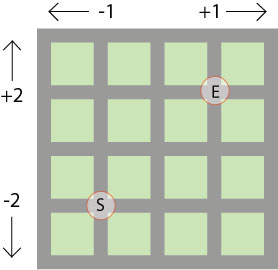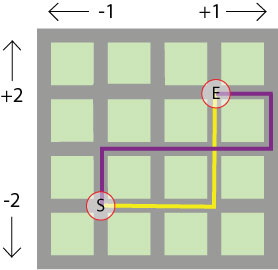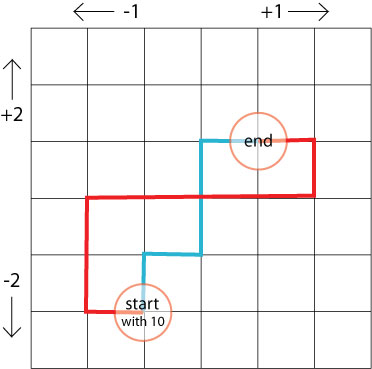Or search by topic
Number and algebra
Geometry and measure
Probability and statistics
Working mathematically
Advanced mathematics
For younger learners
The Add and Take-away Path



- Problem
- Getting Started
- Student Solutions
- Teachers' Resources
The Add and Take-away Path
The Add and Take-away Path printable sheet
Once there was a garden with lots of paths and little patches of grass between them. It looked a bit like this:

Two children, William and Thea, made up a game.
For every patch of grass they passed as they walked to the right on the picture, they added one.
For every patch of grass they passed as they walked to the left on the picture, they took away one.
If they went North (up on the picture), they added two for every patch of grass, and if they went South (down on the picture), they took away two for each patch of grass.
They started with ten points at S, and added and took away until they reached E.

These are the paths they took:

Thea took the yellow path. Remember she started with $10$ points.
How many points did she have when she arrived at E?
William took the purple path.
How many points did he have when he arrived at E?
In the picture below, we've taken out the grass and just drawn a grid. You can imagine that the squares are patches of grass and the lines are the paths in the garden.
We have marked different starting and end points.
What would your score be if you walked along the blue path?
And the red path?

Make up some more paths between these start and end points.
What is your score each time?
What do you notice?
Can you explain why?
Why do this problem?
This problem will give children a chance to generalise and make predictions. It also provides practice in simple addition and subtraction. It draws out the inverse relationship between these two operations as well as encouraging children to think about the order of operations.
Possible approach
You could start by showing the pictures in the first part of the problem to the whole group, making sure that William and Thea's game is understood. A small scale version could be drawn out on the playground or on the hall floor so that the game can be played practically.
Key questions
Possible extension
Possible support
Learners might find it useful to have counters to help keep track of the score. Starting with $10$ counters, they could physically add and take away counters, then count them up when they arrive at the end point.
You may also like
Triangle Animals
How many different ways can you find to join three equilateral triangles together? Can you convince us that you have found them all?
Triple Cubes
This challenge involves eight three-cube models made from interlocking cubes. Investigate different ways of putting the models together then compare your constructions.

